
Despite the hike in world food and energy prices, food consumer price inflation in The Gambia fell by 1% this year. According to the government's budget, the rate fell from 9.3% last year to 8.3% in September 2008.
The government has however revised its projected total revenues and grants for 2008 from D4, 831 million to D3,345 million. The revision is "due to the food and fuel price increases and the financial crisis" according to the Secretary of State for Finance and Economic Affairs Mr. Moussa Gibril Bala-Gaye.
Despite
these revisions the Secretary of State portrayed a solid economic outlook for
The Gambia's "small, open, vulnerable economy which relies heavily on trade and
overseas financial aid flows", saying that real
Grants particularly have been significantly revised from D363 million to D196 million "due largely to the slow progress in the implementation of the European Union road projects."
According
to the Secretary of State Gaye, "the inflationary impact of rising market
prices for food and fuel have been mostly contained up to July 2008". Despite
this, The Gambia reaching the completion point under the enhanced Highly
Indebted Poor Country Initiative and also qualifying for debt relief under the
multilateral debt relief Initiative, "capital expenditure will be revised from
D1,679 million to D755 million, or 1.5 % of
Despite the global economic downturn, Secy. Gaye added, the Gambian government remains committed to its objective of "transforming The Gambia into a financial centre" through ensuring the presence of "strong and sound banks". "In the last three years, the number of banks has risen from seven to eleven".
The sectoral allocation for the coming year sees the servicing of debts eating up the largest proportion of our national budget with a total of 19.76% allocated to "debt service charges". Works construction, and infrastructure are followed closely by education with 14.59% and 14.45% of the budget spending allocated respectively. The Office of the President enjoys a slightly higher allocation than the Department of Agriculture on 4.57% but remains slightly lower than the 5% allocation of the annual budget to meet the costs of the Department of Health and Social Welfare.


